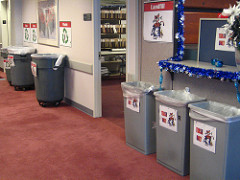Student recycling project
By Mary Bigelow
Posted on 2016-12-29
 I sponsor an after-school science club for upper elementary students. They’d like to expand the recycling program at the school. I’m looking for suggestions on what they can do. – C., Pennsylvania
I sponsor an after-school science club for upper elementary students. They’d like to expand the recycling program at the school. I’m looking for suggestions on what they can do. – C., Pennsylvania
It may help to add a context to your students’ efforts. In a “garbology” lesson, the teacher collects the classroom trash for a week. Students weigh the contents and separate it (wearing gloves) into actual trash and recyclable materials such as paper, cans, bottles. They then weigh the recyclables. By extrapolating this to the number of classrooms in the school, they estimate how much trash was generated in their school and what percentage could be recycled. (See also the lessons in Teaching the Three R’s: Reduce, Reuse, Recycle in the March 2012 issue of Science & Children)
The amount of paper used in the school might be a good start for students’ efforts to reduce, reuse, and recycle. Teachers could save old handouts or outdated materials that were printed on one side. Students could put a box next to the copier for any “mistake” copies with blank sides. Students could then collect and cut the paper in halves or quarters for quizzes, notes, or practice work. This would be one last use before recycling the paper.
Do students drink from water bottles in the classroom? In addition to installing containers to recycle them, club members could begin an awareness program to encourage reusable bottles. (Bottles with the school logo could be a fund-raiser.)
Your members could be “recycling monitors” in their classrooms, reminding others to put materials that could be reused or recycled in the proper containers.
For more ideas, NSTA’s The Science Teacher features the monthly column The Green Room with suggestions on making classrooms and teaching more environmentally friendly. These ideas could be adapted for any level of students.
Photo: http://tinyurl.com/zro35su
Disclaimer: The views expressed in this blog post are those of the author(s) and do not necessarily reflect the official position of the National Science Teaching Association (NSTA).


